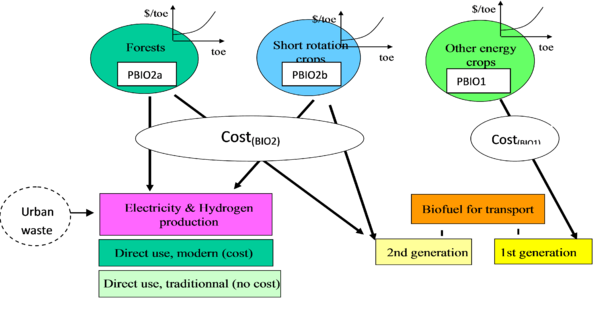Bioenergy - POLES: Difference between revisions
m (1 revision imported) |
No edit summary |
||
| Line 3: | Line 3: | ||
|DocumentationCategory=Bioenergy | |DocumentationCategory=Bioenergy | ||
}} | }} | ||
* | Primary biomass resources for energy uses are classified in 3 categories for all POLES 57 countries / regions: | ||
* | * energy crops (in agricultural area, grassland) | ||
* short rotation crops (cellulosic) | |||
* forest residues (cellulosic) | |||
Energy crops are dedicated to 1st generation biofuels, the 2 other categories are used in all other energy uses (a further split of biomass feedstocks has been implemented for Europe using information from the model GREEN-X). POLES uses by default a simplified modeling of land use to estimate the potential of these resources: land available, yields (evolve over time, based on historical evolutions), share of harvest/land that can be allocated to energy uses. | |||
[[File:36405536.png|none|600px|thumb|<caption>Biomass resource use in POLES</caption>]] | |||
POLES also uses in a standard way exogenous estimates of potentials: for instance a soft linkage with the model GLOBIOM/G4M has been implemented that goves potential estimates and cost curves for all World regions (with the model GREEN-X at EU level). Biomass supply cost curves are attached to the various biomass types and come from GREEN-X, GLOBIOM and other sources. | |||
The conversion into liquid biofuels distinguishes first generation (agricultural energy crops) and second generation (cellulosic). | |||
Information sources include: FAO. | Information sources include: FAO. | ||
Revision as of 16:13, 20 October 2016
| Corresponding documentation | |
|---|---|
| Previous versions | |
| Model information | |
| Model link | |
| Institution | JRC - Joint Research Centre - European Commission (EC-JRC), Belgium, http://ec.europa.eu/jrc/en/. |
| Solution concept | Partial equilibrium (price elastic demand) |
| Solution method | SimulationRecursive simulation |
| Anticipation | Myopic |
Primary biomass resources for energy uses are classified in 3 categories for all POLES 57 countries / regions:
- energy crops (in agricultural area, grassland)
- short rotation crops (cellulosic)
- forest residues (cellulosic)
Energy crops are dedicated to 1st generation biofuels, the 2 other categories are used in all other energy uses (a further split of biomass feedstocks has been implemented for Europe using information from the model GREEN-X). POLES uses by default a simplified modeling of land use to estimate the potential of these resources: land available, yields (evolve over time, based on historical evolutions), share of harvest/land that can be allocated to energy uses.
POLES also uses in a standard way exogenous estimates of potentials: for instance a soft linkage with the model GLOBIOM/G4M has been implemented that goves potential estimates and cost curves for all World regions (with the model GREEN-X at EU level). Biomass supply cost curves are attached to the various biomass types and come from GREEN-X, GLOBIOM and other sources.
The conversion into liquid biofuels distinguishes first generation (agricultural energy crops) and second generation (cellulosic).
Information sources include: FAO.
